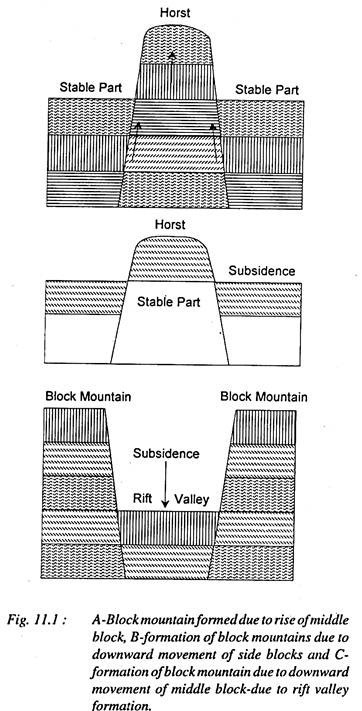ADVERTISEMENTS:
In this article we will discuss about:- 1. Definition of Block Mountains 2. Types of Block Mountains 3. Theories.
Definition of Block Mountains:
Block Mountains id defined as the result of faulting caused by tensile and compressive forces motored by endogenetic forces coming from within the earth, also known as fault block mountains. Block mountains represent the upstanding parts of the ground between two faults or on either side of a rift valley or a graben.
Types of Block Mountains:
Essentially, block mountains are formed due to faulting in the ground surface. Block mountains are generally of two basic types e.g.:
ADVERTISEMENTS:
(i) Tilted block mountains having one steep side represented by fault scarp and one gentle side and
(ii) Lifted block mountains represent real horst and are characterized by flattened summit of tabular shape and very steep side slopes represented by two boundary fault scarps, Block mountains are also called as horst mountains.
Block mountains are found in all the continents e.g.:
(i) Young block mountains around Albert, Warner and Klamath lakes in the Steens Mountain District of Southern Oregon, Wasatch Range in the Utah province etc., in the USA,
(ii) Vosges and Black Forest mountains bordering the faulted Rhine Rift valley in Europe, and
ADVERTISEMENTS:
(iii) Salt Range of Pakistan etc. Sierra Navada mountain of California (USA) is considered to be the most extensive block mountain of the world.
This mountain extends for a length of 640 km (400 miles) having a width of 80 km (50 miles) and the height of 2,400 to 3,600 m (8,000 to 12,000 feet). There is difference of opinions among the scientists regarding the origin of block mountains.
Theories of Block Mountains:
There are two theories for the origin of these mountains viz.:
ADVERTISEMENTS:
(i) Fault theory, and
(ii) Erosion theory.
i. Fault Theory:
Most of the geologists are of the opinion that block mountains are formed due to faulting. The structural patterns of Great Basin Range mountains of Utah province (USA) were closely studied by Clarence King and G.K. Gilbert who named these mountains as faulted blocks (between 1870 and 1875 A.D.).
Since then the mountains formed due to large-scale faulting were named block mountains. Later on G.D. Louder-back opined that Basin Range mountains were formed due to faulting and tilting in the ground surface. W.M. Davis also advocated for the fault theory of the origin of block mountains.
Block mountains are formed in a number of ways:
(i) Block mountains are formed due to upward movement of middle block between two normal faults (fig. 11.1 A). The up-thrown block is also called as horst. The submittal area of such block mountain is of flat surface but the side slopes are very steep.
(ii) Block mountains may be formed when the side blocks of two faults move downward whereas the middle block remains stable at its place (fig. 11.1 B). It is apparent that the middle block projects above the surrounding surface because of downward movement of side blocks. Such block mountains are generally formed in high plateaux or broad domes.
(iii) Block mountains may be formed when the middle block between two normal faults moves downward. Thus, the side blocks become horsts and block mountains (fig. 11.1C). Such mountains are associated with the formation of rift valleys.
ADVERTISEMENTS:
ii. Erosion theory:
J.F. Spurr, on the basis of detailed study of Great Basin Range mountains of the USA, opined that these mountains were not formed due to faulting and tilting, rather they were formed due to differential erosion. According to Spurr the mountains, after their origin in Mesozoic era, were subjected to intense erosion.
Consequently, differential erosion resulted into the formation of existing denuded Great Basin Range mountains. It may be pointed out that erosion theory of the origin of block mountains is not acceptable to most of the scientists because they believe that denudation may modify mountains but cannot form a mountain. In fact, deformatory process play major role in the origin of block mountains.

